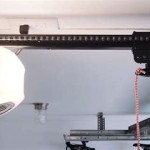How To Install a Garage Door in Sacramento, CA
Installing a garage door is a complex project involving mechanical precision and a keen understanding of safety procedures. While homeowners with advanced DIY skills might consider tackling this project, it's generally recommended to hire experienced professionals in Sacramento, CA due to the potential for significant safety risks and the requirement for specialized tools and knowledge. This article provides a comprehensive overview of the process, emphasizing the necessary steps and potential challenges involved in a garage door installation.
Before embarking on any installation, it's crucial to verify local building codes and permit requirements in Sacramento. The city and county may have specific regulations regarding garage door installations, including specifications for insulation, wind load resistance, and fire safety. Failure to comply with these regulations can result in fines and delays. Contact the Sacramento County Building Inspection Department or the City of Sacramento Building Division to obtain the necessary information and permits before beginning any work.
In Sacramento, CA, the climate can range from hot summers to mild winters, requiring consideration of insulation and weather stripping when selecting a garage door. Choosing a door with an appropriate R-value (insulation rating) can help regulate the temperature inside the garage, reducing energy costs. Proper weather stripping around the perimeter of the door seals gaps and prevents drafts, further enhancing energy efficiency. Furthermore, consider the aesthetic compatibility of the new door with your home's architectural style, as this will affect the overall curb appeal and property value.
Key Point 1: Preparing for the Installation
The initial phase involves meticulous preparation to ensure a smooth and safe installation. This includes removing the existing garage door, inspecting the opening for structural integrity, and gathering all necessary tools and materials.
Begin by safely disconnecting the existing garage door opener. Unplug the unit from the power outlet and disconnect the opener from the door itself. Then, carefully release the tension on the torsion springs. This step is extremely dangerous and should only be performed by someone with the proper tools and expertise. Torsion springs store a significant amount of energy, and improper handling can result in serious injury or even death. If you are not comfortable with this step, it is highly recommended to contact a professional garage door technician.
Once the tension is released, detach the door from the tracks, rollers, and hinges. Work methodically, disassembling the door in sections to reduce the weight and prevent it from falling unexpectedly. Be sure to have a helper available to assist with lifting and maneuvering the door sections. Carefully dispose of the old garage door in accordance with local regulations. Some waste management services may have specific guidelines for disposing of large items like garage doors.
With the old door removed, thoroughly inspect the garage door opening. Look for signs of damage or deterioration in the wood framing, such as rot, cracks, or insect infestation. Repair any damage before proceeding with the installation. Ensure that the header (the beam above the door opening) is level and securely attached. If necessary, reinforce the header with additional bracing to ensure it can support the weight of the new garage door.
Before starting the installation, gather all the necessary tools and materials. This typically includes a level, measuring tape, drill, socket set, wrenches, safety glasses, work gloves, and the new garage door hardware. Lay out all the components in an organized manner to ensure that everything is easily accessible during the installation process. Refer to the manufacturer's instructions for a complete list of required tools and materials.
Key Point 2: Assembling and Installing the Door
This stage is the core of the installation process, where the door sections are assembled, tracks are installed, and the door is mounted within the opening.
Begin by assembling the garage door sections according to the manufacturer's instructions. Typically, this involves attaching hinges, rollers, and reinforcement struts to each section. Ensure that all hardware is securely tightened. The rollers should be installed in the correct positions to ensure smooth and quiet operation of the door. Pay close attention to the orientation of each section to ensure that they are assembled in the proper sequence.
Next, install the vertical tracks along the sides of the garage door opening. Use a level to ensure that the tracks are perfectly plumb. Secure the tracks to the wall studs using lag screws or other appropriate fasteners. The tracks must be securely mounted to prevent them from shifting or bending under the weight of the door. Check the alignment of the tracks to ensure that they are parallel and evenly spaced. Any misalignment can cause the door to bind or operate erratically.
Once the vertical tracks are installed, attach the horizontal tracks to the vertical tracks and the garage ceiling. Use the appropriate brackets and fasteners to ensure a secure connection. The horizontal tracks should be level and properly supported to prevent sagging. Pay close attention to the positioning of the horizontal tracks to ensure that the door will open and close smoothly. The track dimensions can vary depending on the type of garage door and the track radius.
With the tracks in place, carefully lift the assembled door sections into the tracks. Start with the bottom section and work your way up, securing each section to the tracks as you go. Use a helper to support the weight of the door sections while you are attaching them to the tracks. Ensure that the rollers are properly seated in the tracks and that the door sections are aligned correctly.
Key Point 3: Installing the Spring System and Garage Door Opener
This final step involves installing the critical spring system and the garage door opener, requiring careful attention to safety protocols and precise adjustments.
The spring system, whether it is a torsion spring or extension springs, is responsible for counterbalancing the weight of the garage door. Torsion springs are typically mounted above the door opening, while extension springs are mounted on either side of the door. Installing and adjusting the spring system is a potentially dangerous task that should only be performed by experienced professionals. Improperly installed or adjusted springs can cause the door to operate unsafely or even cause serious injury. Ensure the springs are properly wound and secured, following the manufacturer's instructions meticulously.
After installing the spring system, install the garage door opener. Attach the opener to the ceiling joists using appropriate brackets and hardware. Connect the opener to the door using the provided arm and hardware. Adjust the opener's travel limits and force settings according to the manufacturer's instructions. These settings determine how far the door opens and closes and how much force the opener applies. Incorrect settings can cause the door to slam shut or fail to open completely.
Finally, test the operation of the garage door. Ensure that the door opens and closes smoothly and evenly. Check the safety features of the opener, such as the safety sensors that prevent the door from closing if an obstruction is detected. Make any necessary adjustments to ensure that the door operates safely and reliably. After the installation is complete, thoroughly inspect the entire system to ensure that all components are properly installed and functioning correctly.
Throughout the entire installation process, prioritize safety. Wear safety glasses and work gloves to protect yourself from injury. Use a ladder that is properly rated for the weight you will be carrying. Be careful when lifting heavy objects. If you are not comfortable with any aspect of the installation, it is best to consult with a professional garage door technician in Sacramento, CA.
The installation of a garage door requires a significant amount of technical knowledge, skill, and experience. It is crucial to adhere to safety guidelines and local building codes to ensure a successful and safe installation. While some homeowners might attempt a DIY installation, professional installation is highly recommended due to the inherent risks and complexities involved.

1a Garage Doors Installing Glass In Sacramento Ca

Precision Garage Door Sacramento Valley Repair Openers New Doors

Change Wood Garage Door To Roll Up Roseville

Garage Door Repair And Installation Services In Sacramento Ca

Precision Garage Door Sacramento Valley Repair Openers New Doors

Top 10 Best Garage Door Repair In Sacramento Ca Updated 2025 Yelp

Informative Blogs About Garage Door Repair And Installation

Precision Garage Door Sacramento Valley Repair Openers New Doors

Garage Door Repair Sacramento Ca Lms Doors

Change Wood Garage Door To Roll Up Roseville
Related Posts








